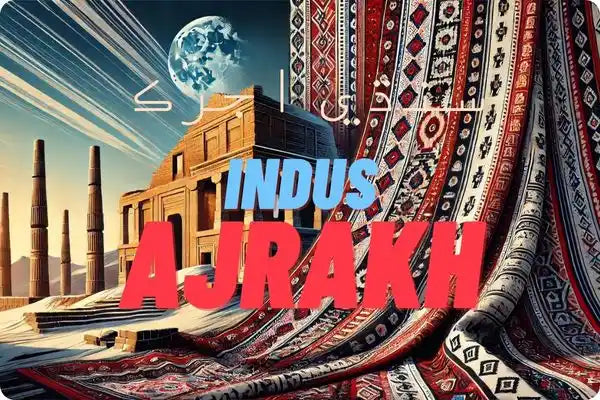
Indus Ajrakh: A Timeless Symbol of Sindhi Heritage
Share
Indus Ajrakh is a traditional block-printed cotton that holds immense traditional significance in the regions of Sindh, Pakistan, and parts of India. This beautiful piece of cloth is more than just a piece of cloth; it represents the rich heritage, history, and traditions of the Indus Valley Civilization. Known for its striking geometric patterns and deep hues of red, black, and white, This cultural emblem is an essential part of Sind identity and is deeply rooted in the cultural piece of cotton of the region.
In this content, we will explore the history, importance, and uses of indigo printed cotton master piece, along with its variations, colors, and traditional names. We will also discuss how it is used in celebrations, gifted to guests, and cherished as a folklore symbol.
Table of contents
· Ancient roots of the master piece of pure cotton
· Ajrak and the Mehran valley civilization
· Etymology of the word Ajrakh
· Spread of Ajrakh beyond Sindh
· Legacy significance through the Ages
Ancient roots of the master piece of pure cotton
The history of Iconic textile & Topi dates back to 5,000 years ago, tracing its origins to the Mehran Valley Civilization. Archaeological evidence from Mohenjo-Daro, one of the major cities of this ancient civilization, shows that block-printed pure cotton similar to اجرڪ were in use as early as 2,500 BCE. A sculpture of a priest-king discovered at Mohenjo-Daro shows a draped scarf featuring a trefoil pattern, which closely resembles modern Ajrakh designs.

This historical link makes master piece of textile one of the oldest surviving textile traditions in the world. It is believed that the craft of Sind block art was practiced by Sind artisans and craftsmen who passed down their knowledge from generation to generation.
Ajrak and the Mehran valley civilization
The Mehran Valley people were known for their advanced dyeing techniques and textile production skills. The dyed cotton scarf was made using natural dyes derived from plants, minerals, and other natural sources. The use of indigo dye—a distinctive color seen in Ajrak—was prevalent in the region, and Sindh became known for producing the best quality indigo dye.
The process of block printing on pure cotton cloth with intricate geometric patterns has been preserved through centuries, making Ajrak a living legacy of the ancient civilization.
Etymology of the word Ajrakh
The word ‘اجرڪ’ is derived from the Arabic word ‘Azrak’, which means blue. The cotton shawl is often characterized by the use of deep blue and rich red colors, both of which hold ancestry and symbolic significance in Sindh.
Another interpretation of the word suggests that ‘Ajrak’ could be derived from the Sindhi phrase ‘Aj Rakh’, which means ‘keep it today’. This phrase is believed to signify the daily use of Indigo fabric, indicating its importance in the lives of the people of Sindh.
Spread of Ajrakh beyond Sindh
Over time, the popularity of Sind's geometric print shawl spread beyond Sindh to other regions, including Rajasthan and Gujarat in India, and even worldwide like USA, where similar block-printing techniques are practiced today. However, Sindh remains the true home of Ajrak, where it is woven into the ancient fabric of the Sindh.
Sindhi traders played a crucial role in spreading the geometric print scarf across the Middle East, Central Asia, and Africa. The fabric was exchanged as a precious commodity, and its unique patterns made it a sought-after item in different parts of the world.
Legacy significance through the Ages
Sindhi block art has always been more than just a fabric. In ancient times, it was worn by royalty and the elite class as a symbol of wealth and prestige. President Asif Ali Zardari also celebrates the Ekta day with wearing ajrakh and topi. Over time, it became an integral part of everyday life for Sindhi people, used as a shawl, turban, or blanket.
During various historical periods, iconic textile was presented as a gift to honor distinguished guests or as a token of respect. Even today, This master iconic shawl is given to guests during Sindhi traditional events, weddings, and festivals, symbolizing hospitality and respect.
In addition to traditional uses, Indus Ajrak is now widely used in modern fashion and home decor. It is commonly seen on purses, masks, and even car plates with Ajrak prints. Furthermore, Ajrak designs are popular on T-shirts for both men and women, as well as bed sheets. Many also hang Ajrak fabric on walls as a fashionable decorative piece, making it a token of admiration for Ajrak lovers.
The iconic textile has evolved from its ancient roots to become a global symbol of Sindhi heritage, representing resilience, peace, and cultural pride.
Bottom-line
In conclusion, Ajrak is not just a fabric, but a vibrant symbol of Sindhi culture, embraced by political leaders, NGO workers, and students alike. Its rich heritage continues to unite communities, preserving the legacy of the Indus region and proudly marking cultural identity.
